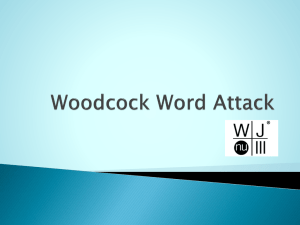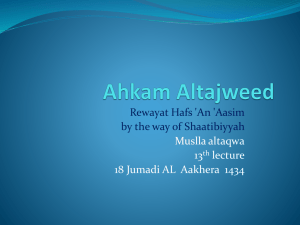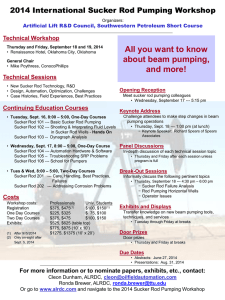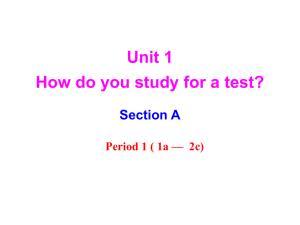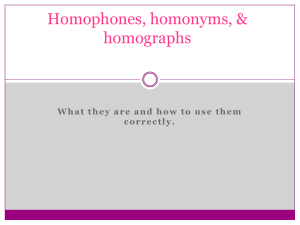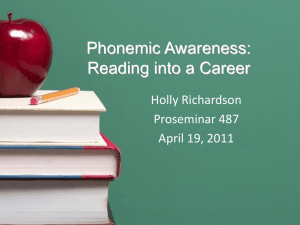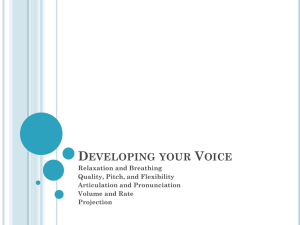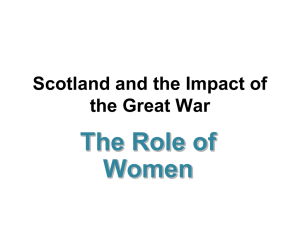transterminology
advertisement
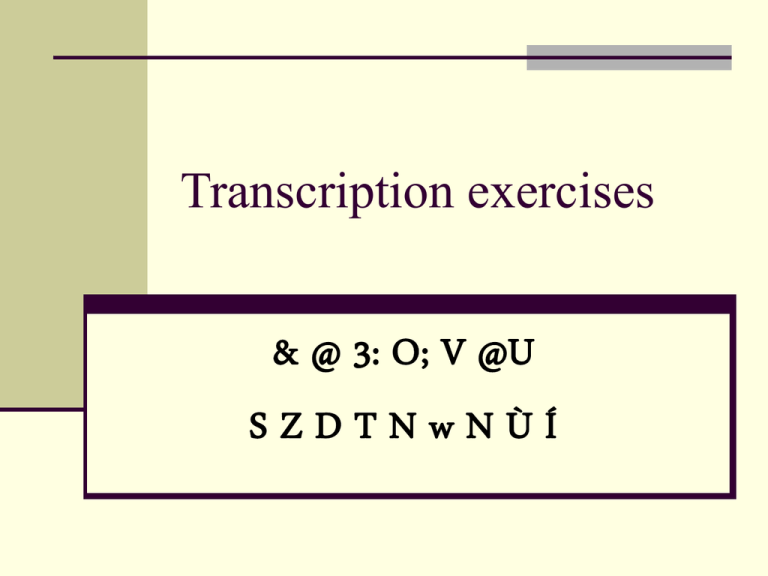
Transcription exercises & @ 3: O; V @U SZDTNwNÙÍ Phonemic alphabet in English Only 44 phonemes? i: I U u: I@ eI e @ 3: O: U@ OI @U & V A: Q e@ aI aU p b t d tS dZ k g f m v n T N D h s l z r S w Z j Matching exercise 1: Match pronunciation terms with their transcription. pronunciation phonetic transcription phonemic symbols phonemes vowels consonants letters / vaUlz/ /"let@z/ / !Int@"n&S@n@l f@U"ni;mIk pronounce International Phonemic Alphabet "&lf@bet/ /"kQnts@n@nts/ /pr@"naUnts/ /f@U"ni;mIk "sImb@lz/ /"f@Uni;mz/ /f@U"netIk tr&n"skrIpS@n/ /pr@%nVntsi"eISn/ Matching exercise 1 : Pronunciation terminology & its transcription KEY pronunciation phonetic transcription phonemic symbols phonemes vowels consonants letters pronounce International Phonemic Alphabet /pr@%nVntsi"eISn/ /f@U"netIk tr&n"skrIpS@n/ /f@U"ni;mIk "sImb@lz/ /"f@Uni;mz/ /"vaUlz/ /"kQnts@n@nts/ /"let@z/ /pr@"naUnts/ / !Int@"n&S@n@l f@U"ni;mIk "&lf@bet/ Matching exercise 2: Match pronunciation terms with their transcriptions slanting brackets square ones aspiration diacritics Roman alphabet animation British English American English features sound sequences minimal pairs vocal cords /"slA;ntIN/ /"skwe@/ / !v@Uk@l"kO;dz/ /!&sp@"reIS@n/ /"&lf@bet/ /wVnz/ /"si;kw@ntsIz/ /@ !merIk@n/ /saUnd/ /!&nI"meIS@n/ / !brItIS/ /!r@Um@n/ /"INglIS/ /!daI@"krItIks/ /"br&kIts/ /"fi;Í@z/ / !mInIm@l"pe@/ Matching exercise 2: Pronunciation terminology & its transcription KEY slanting brackets square ones aspiration diacritics Roman alphabet animation British English American English features sound sequences /"slA;ntIN "br&kIts/ /"skwe@ wVnz/ /!&sp@"reIS@n/ /!daI@"krItIks/ /"r@Um@n"&lf@bet/ /!&nI"meIS@n/ /!brItIS "INglIS/ /@ !merIk@n"INglIS/ /"fi;Í@z/ /"saUnd"si;kw@ntsIz/ Reading aloud 1 From transcription to pronunciation Can you read these words? /pr@%nVntsi"eISn/ /"slA;ntIN "br&kIts/ /f@U"ni;mIk "sImb@lz/ /!&sp@"reIS@n/ /f@U"netIk tr&n"skrIpS@n/ /"f@Uni;mz/ /"vaUlz/ /"kQnts@n@nts/ /"let@z/ /pr@"naUnts/ / !Int@"n&S@n@l f@U"ni;mIk "&lf@bet/ /"skwe@ wVnz/ /!daI@"krItIks/ /"r@Um@n"&lf@bet/ /!&nI"meIS@n/ /!brItIS "INglIS/ /@ !merIk@n"INglIS/ /"fi;Í@z/ /"saUnd"si;kw@ntsIz/ Reading aloud 2 From spelling to pronunciation Can you read these words? slanting brackets pronunciation square ones phonetic transcription aspiration phonemic symbols diacritics phonemes Roman alphabet vowels animation consonants British English letters American English pronounce features International Phonemic sound sequences Alphabet Writing 1 From transcription to spelling. Can you write these words? /pr@%nVntsi"eISn/ /"slA;ntIN "br&kIts/ /f@U"ni;mIk "sImb@lz/ /!&sp@"reIS@n/ /f@U"netIk tr&n"skrIpS@n/ /"f@Uni;mz/ /"vaUlz/ /"kQnts@n@nts/ /"let@z/ /pr@"naUnts/ / !Int@"n&S@n@l f@U"ni;mIk "&lf@bet/ /"skwe@ wVnz/ /!daI@"krItIks/ /"r@Um@n"&lf@bet/ /!&nI"meIS@n/ /!brItIS "INglIS/ /@ !merIk@n"INglIS/ /"fi;Í@z/ /"saUnd"si;kw@ntsIz/ The schwa /@/ Circle all the syllables containig the schwa and then try to sing the song. Glen Hansard - Broken Hearted Hoover Fixer Sucker Guy Lyrics ONCE Ten years ago I fell in love with an Irish girl She took my heart But she went and screwed some guy she knew and now I'm in Dublin with a broken heart Oh broken hearted Hoover fixer sucker guy Oh broken hearted Hoover fixer sucker, sucker guy One day I'll go there and win her once again but until then I'm just a sucker of a guy (http://www.stlyrics.com/lyrics/once/brokenheartedhooverfixersuckerguy.htm) Here are all the schwas /@/ in Hansard’s Broken Hearted Hoover Fixer Sucker Ten years ago I fell in love with an Irish girl She took my heart But she went and screwed some guy she knew and now I'm in Dublin with a broken heart Oh broken hearted Hoover fixer sucker guy Oh broken hearted Hoover fixer sucker, sucker guy One day I'll go there and win her once again but until then I'm just a sucker of a guy There is no schwa in THERE and AGO,GO as /@/ is part of two different diphthongs /e@/ and /@U/. In DUBLIN it is a minority pronunciation: /"dVbl@n/. There is /e/ in THEN. (http://www.stlyrics.com/lyrics/once/brokenheartedhooverfixersuckerguy.htm) Practice makes perfect. It’s not a piece of cake, is it? Now you deserve one. Or a cup of tea or coffee? Frequently asked questions 1. 2. Why is there /@/ and /@/ in the word / !Int@"n&S@n@l/ ? How do I know when to use a dotted /i/ or undotted /I/? 3. Why are some words (e.g./wVnz/) without stress marks? 4. 5. Why is the grammatical ending transcribed sometimes as /s/, /z/, or /Iz/ in /"br&kIts/, /"fi;Í@z/, and /"si;kw@ntsIz/? Why are stresses in /@ !merIk@n"INglIS/ like this when the dictionary tells us it should be /@"merIk@n/ /"INglIS/? 6. Why do they say /pr@"naUnts/ and not /pr@"naUns/? 1. Why is there /@/ and /@/ in the word / !Int@"n&S@n@l/ ? Because the second and the third schwa in the word / !Int@"n&S@n@l/ may be pronounced, or may be ommited. It is called a superscript schwa and it is a non-phonemic symbol. 2. How do I know when to use a dotted /i/ or undotted /I/? Can you spot any regularities stemming from these examples? /i/ /i;/ /I/ /"praIm@ri/ /"3;li/ /f@U"ni;mIk/ /"si;kw@nts/ /"fi;Í@z/ /"slA;ntIN/ or /"br&kIts/ /"f&mIliz/ /"f&kt@riz/ / !i;k@"nOmIk/ / !Int@"n&S@n@l/ /"INglIS/ /greI/ or /seI/ /pr@%nVntsi"eISn/ /"h&pi@/, /ve@ri@s/ /!i;k@"nOmIk/ /!&nI"meIS@n/ /i/ or /i;/ or /I/ ? /i/ is used at the end of words when it is not part of the diphthong (e.g. /leIdi/) and in plural endings (e.g. /leIdiz/). /i;/ occurs at the beginning and in the middle of a word to mark the long vowel. It never occurs at the end of a word (e.g. / !i;k@"nOmIk/, /ri;d/). /I/ can be found only at the beginning or in the middle of a word. It also occurs at the end of a word when it is part of a diphthong (e.g. / !I"regj@l@, /bIt/, /bOI/). /i/ can sometimes be in the middle of the word when it is in front of a stressed suffix, for example, /pr@%nVntsi"eISn/, or in front of a vowel which is part of a suffix /"ve@ri@s/ or grammatical ending /"h&pi@/. 3. Why are some words (e.g./wVnz/) without stress marks? Because no one-syllable words are marked with stress marks in dictionaries. 4. Why is the grammatical ending –s transcribed sometimes as /s/, /z/, or /Iz/? /s/ /z/ /Iz/ /"br&kIts/ /"fi;Í@z/ /"si;kw@ntsIz/ /"kQnts@n@nts/ /wVnz/ /"bVsIz/ /k&ps/ /"sImb@lz/ /"m&ÍIz/ /s/, /z/, or /Iz/? Unvoiced, voiced or sibilant? What matters is what type of a consonant comes before the grammatical ending in pronunciation of a word. When there is an unvoiced consonant, the grammatical ending –s is pronounced as /s/, e. g. /k&ps/. When there is a voiced consonant or any vowel, the grammatical ending –s is pronounced as /z/, e. g. /"fi;Í@z/, /wVnz/. When there is a sibilant consonant /s, z, S, Z, Í, Ù, the grammatical ending –s is pronounced as /Iz/, e. g. /"bVsIz/, /"m&ÍIz/ 5. Why does primary stress become secondary when two words meet? The primary stress becomes secondary in /@ !merIk@n"INglIS/ because when two words meet in speech, they influence each other in many different ways in English even if the dictionary tells us it should be /@"merIk@n/ and /"INglIS/. Have you spotted any other cases like thisin the exercises above? But it can be also the other way round: /"fIfti;n !egz/ but /fIf"ti;n/ /egz/. 6. Why do they say /pr@"naUnts/ and not /pr@"naUns/? Because this is the trend in current development of RP. Have a look at words such as pronunciation, occurrence, difference, fence, or answer in the 3rd edition of LPD. Great. Well done. You’re the winner.


